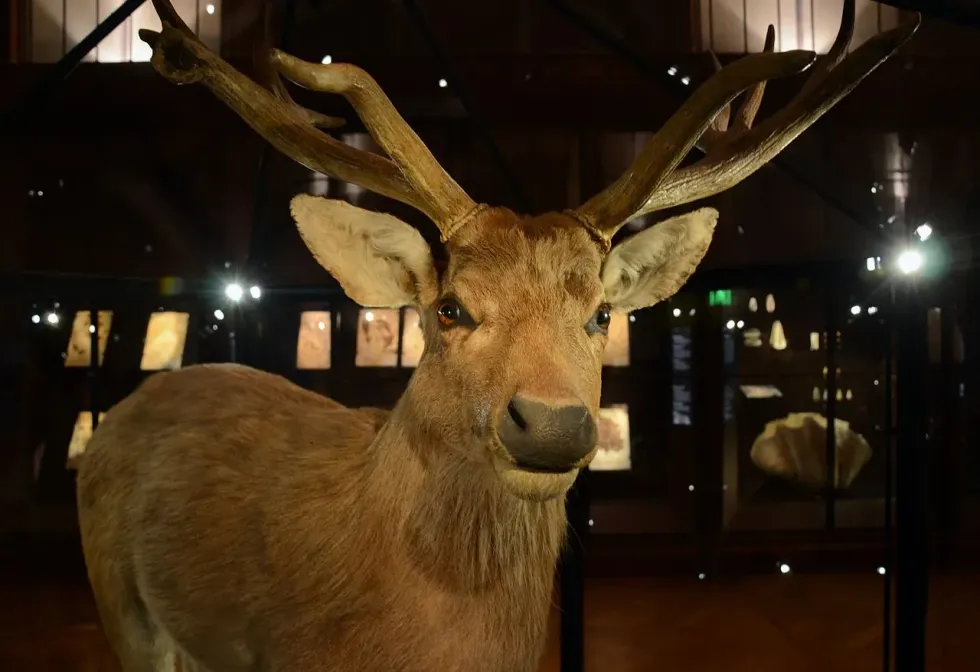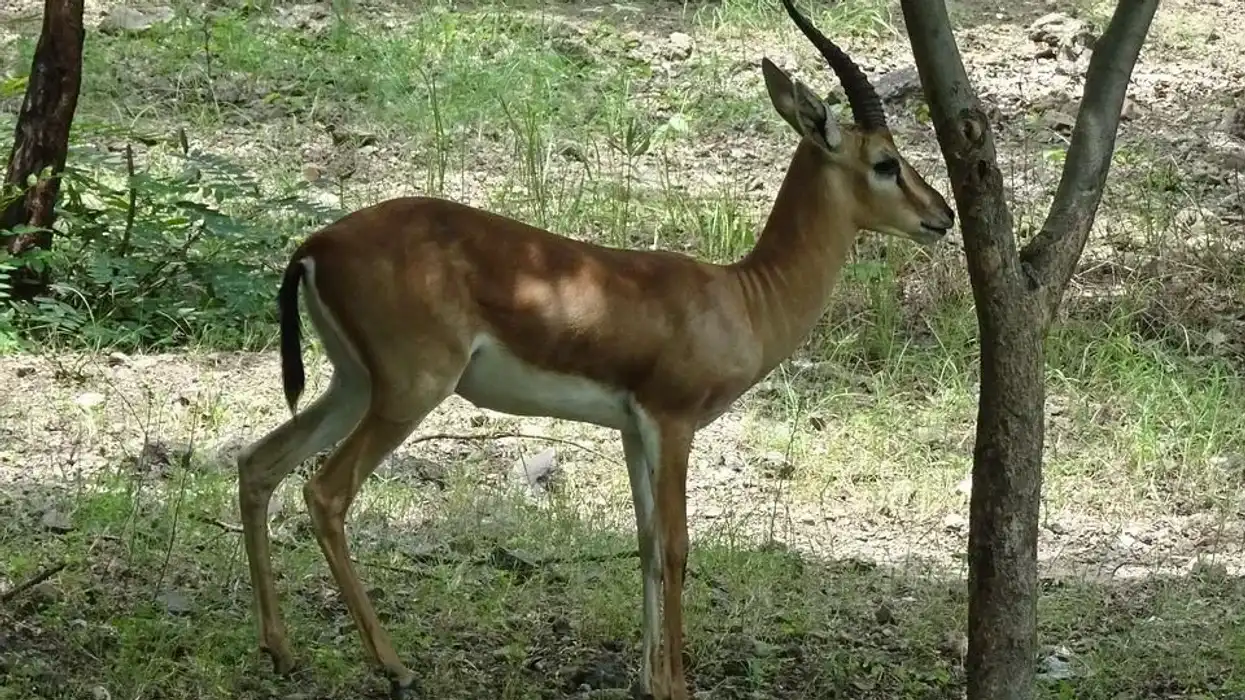Schomburgk's deer, Rucervus schomburgki, is an extinct species of deer and was a member of the family Cervidae. First described in 1863 and named after Sir Robert H. Schomburgk.
This species of deer with antlers received very little attention until it went on the road to extinction. There were various scientific expeditions to search for this species in the early 1900s, but it was described that the deer was already locally extinct.
The Schomburgk's deer was said to be dead in their wild habitat in 1932 and the last known species to be captivated was killed in 1938. All the photos described a single male that lived in the Berlin Zoo from 1899-1911.
The males of the species had basket-like antlers where all main tines branched and the deer had up to 33 points on their antlers. The females, however, had no antlers.
The Schomburgk's deer was said to resemble the Barasingha and the Brown-antlered deer, both members of the same genus as the species of deer we are currently discussing.
There is not much information on the physical characteristics of the species but were said to resemble the Barasingha deers a lot. Due to this misunderstanding, many species caught by people from the wild in Central Thailand were just considered to be the Barasingha deer.
Read on to discover more about the species that vanished from existence. We also have some interesting facts about the Swedish Lapphund and the Mountain Beaver only on the Kidadl website.
Schomburgk's Deer Interesting Facts
What type of animal is a Schomburgk's Deer?
The Schomburgk's deer is a species of deer that has now gone through extinction.
What class of animal does a Schomburgk's Deer belong to?
The Schomburgk's deer, Rucervus schomburgki, fell under the class of Mammalia in the kingdom of Animalia.
How many Schomburgk's Deers are there in the world?
The species of deer has now been extinct for a few years now. Some content is available where scientists believe that this species might still be alive and can come out of extinction. In 1991, a pair of antlers were discovered in a Chinese medicine shop in Laos. These antlers were freshly cut according to scientists.
Where does a Schomburgk's Deer live?
These deers were endemic to the country of Thailand and the range was specifically the Chao Phraya River valley in Bangkok. In Europe, one male deer was brought by the German director and offered to the Berlin Zoo. Before that, the last specimen died in a European zoo three years ago.
The Barasingha deer of India and the Brown-antlered deer from Eastern Thailand, Laos, and Cambodia are the closest relatives of the Schomburgk's deer.
What is Schomburgk's Deer's habitat?
R. schomburgki had its habitat in swampy plains with long grass, cane, and shrubs in the Central Thailand region. They were found particularly in the Chao Phraya River Valley near Bangkok, Thailand.
Their habitat included grassy lands and they avoided dense vegetation. During floods, the issues increased for them as they were forced to higher grounds which made them easy targets for hunters.
Who do Schomburgk's Deer live with?
They were usually seen in herds that consisted of a single adult male, a few females, and the young.
How long does a Schomburgk's Deer live?
They used to probably live for around 20 years, the same as the Barasingha.
How do they reproduce?
The reproduction presumably resembled that of the Barasingha Deer of India, with one young per breeding season. Sexual maturity is reached in two to three years.
After the breeding season, they made herds that consisted of the alpha single adult male, a few females of the group, and the newly-born young. They were seen grazing in a habitat that avoided dense vegetation.
What is their conservation status?
The Schomburgk's deer was listed as extinct in the year 2006 by the IUCN Red List. The status of extinction was last assessed on 19 November 2014.
During the rainy season, the herds that consisted of a large number of the species of male, a few females, and young were forced onto the higher land elevation area in their habitat. These areas in intense rain turned into islands isolating the deer species.
This made them easy targets for hunters. The deer species were affected by overhunting in Thailand in the early 1900s and finally, they vanished from the wild in 1932. One specimen in captivity was slaughtered in 1938.
Schomburgk's Deer Fun Facts
What do Schomburgk's Deers look like?
Schomburgk's deer had a dark brown pelt. They had lighter underparts. The underside of the tail was generally white. They were quite similar in appearance to the barasingha. The males had basket-like antlers.
They had 16-20 tines, with up to 33 tines recorded. The Barasingha has only around 12 tines in comparison. The large antlers on the dark brown body were the highlight of this species. Other than that, there is not much information available on the physicality of the deers. The females did not have antlers.
How cute are they?
They were considered beautiful.
How do they communicate?
There is no data available to know about their mode of communication.
How big is a Schomburgk's Deer?
The size of the Schomburgk's Deer is not known. They were presumed to be similar in size to the Barasingha Deer. The head and body length of the Barasingha is about 71 in. The shoulder height is 41 in. The tail length is 4 in. The outer edge of the rack was presumed to be about 35 in long.
How fast can a Schomburgk's Deer move?
The speed of the Schomburgk's Deer is unknown. The Barasingha Deer can run at a speed of 30 mph.
How much does Schomburgk's Deer weigh?
The size of the Schomburgk's Deer resembles the Barasingha Deer. The weight of the Barasingha Deer ranges from 374-616 lb.
What are the male and female names of the species?
Males and females were not given different names.
What would you call a baby Schomburgk's Deer?
They were called young or juvenile.
What do they eat?
The diet of the Schomburgk's deer presumably included grasses, reeds, and swamp vegetation.
Are they poisonous?
They were not considered poisonous. People used to hunt these deers for food too.
Would they make a good pet?
These deers have gone extinct now so it is not possible to have them as a pet.
Did you know...
Schomburgk's deer was described from a pair of antlers by Edward Blyth in 1863. It takes its name from the former Bangkok British consul (1857-1864), Sir Robert H. Schomburgk.
The last deer is said to have been killed in 1938 and gone extinct, but some content is available stating that the deer might still be alive.
The last deer photographed in the Berlin Zoo was offered to the zoo by the German director of the Thai Railway. When the director was about to return to Germany, he offered all his animals to the Zoo. The Schomburgk's deer was gifted to the German director by the Thai governor in the Saraburi province.
They used to shed their antlers during/after the breeding season.
How did Schomburgk's deer go extinct?
R. schomburgki went extinct as the commercial production of rice in Thailand in the 19th century for export destroyed all the grasslands and swamp areas in the area. The Schomburgk's deer depended on it. Also, hunting practices added to the misery of the species and was the added reason for extinction for the deers with the basket-like antlers.
When did Schomburgk's deer go extinct?
In the year 1932, the Schomburgk's deer died out of overhunting in the wild. The last captive specimen was killed in 1938. That was the last time the deers were seen in any range.
Here at Kidadl, we have carefully created lots of interesting family-friendly animal facts for everyone to discover! Learn more about some other mammals from our tufted deer facts and Indian hog deer fun facts pages.
You can even occupy yourself at home by coloring in one of our free printable Schomburgk's deer coloring pages.










